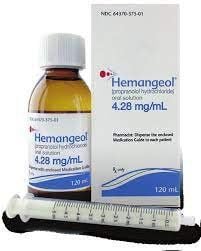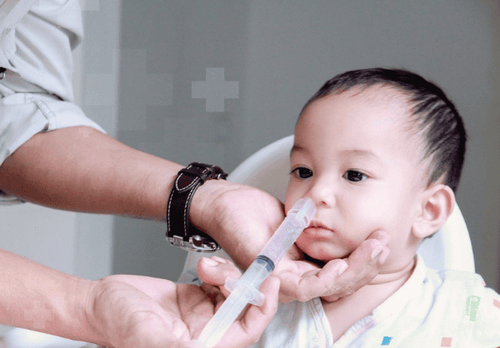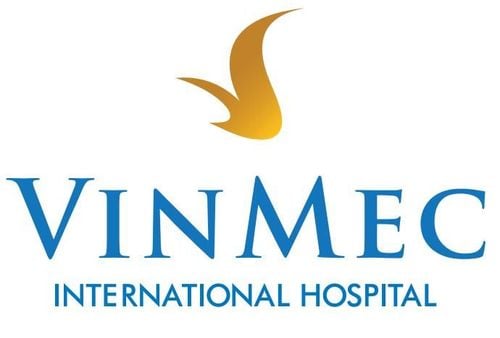This is an automatically translated article.
The article was professionally consulted by Specialist Doctor II Tran Van Trong - Specialist in Pediatric Surgery, Plastic Surgery - Aesthetics - Department of General Surgery, Vinmec Danang International Hospital1. What is a hemangioma?
Infantile hemangioma is a benign tumor. Hemangiomas are common in the Caucasian population, they appear more often in girls and premature babies, low birth weight (less than 1000 grams).
Neonatal hemangioma can be seen at birth or the first few weeks or even the first few months of life. However, most hemangiomas will become apparent by 2-3 weeks of age. They often appear anywhere on the body such as hemangiomas on the palms, or neck, face...

The cause of these hemangiomas is still not well understood, but the researchers say they are not related to drug use during pregnancy nor to any environmental exposure. In the case of inheritance, it is even more rare. Current research is focusing on progenitor cells of hemangiomas to learn more about the origin and etiology of the disease.
Hemangiomas in young children almost always have a growth (proliferative) phase followed by a shrinking phase. Most hemangiomas begin in the proliferative stage shortly after birth. This phase usually lasts for 4-6 months and can also be shorter or longer. Each lesion has its own growth schedule. The time in the shrinkage stage can take up to 10 years. In some children, even the vascular tumors shrink completely, leaving fatty tissue and small dilated blood vessels in the skin.
2. Should children with palmar hemangioma have surgery?
Most hemangiomas shrink completely and do not require treatment. However, all children with hemangiomas should undergo a thorough evaluation for appropriate treatment. The decision on whether to treat and when to do so is made on the basis of an individual analysis. Age, location of hemangioma, type of hemangioma, progression of hemangioma, and potential short- and long-term complications should be considered.

Treatment of hemangiomas in general and hemangiomas in the palm in particular can use the following methods:
Drug treatment: This is a medical treatment used for complicated hemangiomas in the early stages. proliferation. The aim is to slow the growth and reduce the size of the lesion to prevent possible further complications. Medical treatment can be used topically, injected locally, orally or intravenously. Laser therapy: This therapy is used to treat hemangiomas who may have ulcers. However, this therapy is not effective in treating the growth stage of hemangiomas and can cause significant scarring. Surgery: Surgery will be recommended for certain patients such as: children with hemangiomas and ulcers that do not heal, children with lesions that interfere with breathing, people with hemangiomas that are already scarred or deformed , drug treatment but no results. Palm hemangiomas may be delayed surgical treatment in the hope that the hemangioma will regress after some time, depending on the type of hemangioma. However, when palm hemangioma develops, it affects the body's function along with many other complications such as ulceration, necrosis, secondary infection, bleeding... and is accompanied by amputation. Extremities including hands need to be treated surgically at this time.
One of the methods of treating palmar hemangiomas is cryotherapy, injecting into the sclerosing tumor and irradiating it. However, the impact on the scleroderma in the palm of the hand can create fibrosis, leading to poor treatment results and limiting the effect of removing lesions as well as possibly transforming into malignant tumors.
Palm hemangiomas are often larger than they seem, and they tend to invade deep into tissue. This makes it difficult to manage vascular malformations that spread across regions of the body. Therefore, tumor surgery will be considered on a case-by-case basis to minimize possible serious complications. At the same time, the surgical process is carried out with extreme care to preserve important structures and limit the recurrence rate of the disease.
After surgery is also a process that needs attention. Since this is an early stage, possible complications can be identified and treated. Three days after surgery, the skin secondary to the hematoma will be noticed and resolved with surgical drainage of the hematoma.
Thus, it can be concluded that surgical treatment of palmar hemangiomas in children is possible and should be performed in the following cases: the hemangioma grows more and more, but drug treatment fails; Hemangiomas limit the body's growth and function and pose a risk of serious complications.
Please dial HOTLINE for more information or register for an appointment HERE. Download MyVinmec app to make appointments faster and to manage your bookings easily.














